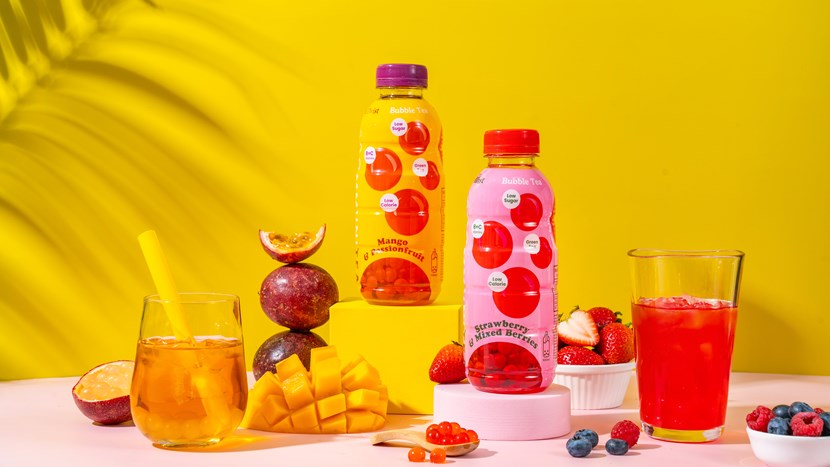Finding the sweet spot with bubble tea
Topics

“This project has shown us the importance of exploring different flavour profiles globally”.
Founded in 2013 by siblings May Gem and Liam Tan, Tempo Tea Bar brought Scotland its first standalone bubble tea bar. Today, it’s expanded beyond its Glasgow city-centre shop to manufacture canned products and “make your own” home kits.
Their mission is to change people’s perception of tea and introduce the world to the versatility of bubble tea so everyone can live a healthier, more fun life.
What was in your thought bubble?
Bubble tea, a popular drink from Taiwan, is ypically high in sugar. We’ve developed our own recipes to make it healthier but still full of flavour, boosting our product with B vitamins,
vitamin C and tea extract, and we wanted to take it a step further.
We were awarded £3,000 from the Healthier Food Service Fund to support a sugar reduction project. With this funding, our aim was to create a long shelf-life bubble tea product that was HFSS-compliant (restrictions on promoting products high in fat, salt, or sugar) to fill an identified gap in the market.
What we did
Before this project, we were working with a small range of six flavours. We wanted to expand our flavour range by sourcing a new supplier of low-sugar syrups. The reformulation process took a couple of months towards the end of 2024. It was a collaborative effort between
co-owner Liam and Jerrica, who works in our development kitchen.
Over the course of a year, we had tried to find a UK manufacturer for these syrups,
but it proved difficult.
Logistically, it made sense to find a manufacturer in Asia as our popping boba and other toppings are already sourced from China and Taiwan. We decided to use the £3,000 funding to explore international options to create sugar-free syrups sweetened with stevia. We approached three companies - in Taiwan, China and in Vietnam - to get the syrup formulation correct.
We first worked with the Vietnamese company, but there was a miscommunication that resulted in a product that still had a higher sugar content than we wanted.
We then pivoted and approached the Chinese company. Their team was able to create the correct formulation for our new syrups.
The findings
The reformulation project successfully yielded a new bubble tea syrup with
exceptional results.
- The syrup itself contains just 0.5g of sugar per 100ml, while many standard syrups contain 60-70g per 100ml.
- When used in a final ready-to-drink (RTD)
product, our bubble tea now contains just 3g of sugar per 100ml, which is significantly lower than the market standard which can be around 7-10g per 100ml. - This has allowed us to extend our range with new flavour profiles, including a tropical mix and a berry mix, which was a core aim of the project.
The benefits and learning points
This project was just the starting point for us. Our initial hurdle was simply finding a manufacturer who could get the formulation correct, and we learned some invaluable
essons along the way.
Communicating clearly: the biggest lesson was the importance of terminology. When working with the Vietnamese manufacturer, we believe there was a miscommunication between “sugar-free” and “no added sugar”. They used natural fruit purées so while no sugar was added, the sugarcontent was still too high for our goal. This experience reinforced how crucial it is to be very specific with requirements when working with international partners.
Strengthening our supply chain: we found that Asian companies possess a deeper understanding of the specific flavour profiles required for bubble tea, something UK suppliers previously struggled with.
For instance, a passion fruit syrup from a UK supplier always tasted more like mango or just sweet, without the tartness we were looking for. This project has shown us the importance of exploring different flavour profiles globally and not limiting our search to local suppliers. This experience has been key to strengthening our supply chain for the future.
Expanding our market: the benefits of this reformulation are huge for our business. Not only can we now use these syrups in our in-store drinks and home kits, but we have also created a longer shelf-life product (over a year), which opens the door to the B2B wholesale market. This was a key piece of feedback from stockists and wholesalers we’ve spoken to and that RTD bubble tea market is going to really start growing.
The new product is also at a more accessible pricepoint to the general public. This gives us crucial data on the demand for low-sugar bubble tea in a bottled format, which we have not explored before as our drinks are typically in clear cans.
We are also now exploring the potential of working with the manufacturer to reduce the sugar content of the popping boba, which currently is the main source of sugar in the RTD product, since the tea concentrate is sugar-free.
